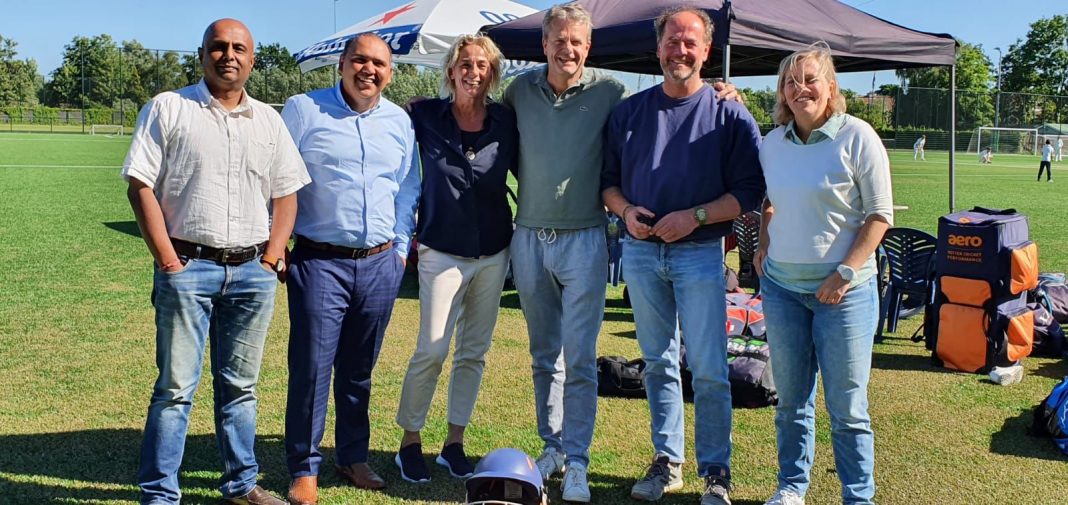‘We want to create a positive buzz around Dutch cricket,’ says the KNCB’s new chairman, Guido Landheer, ‘building on a heritage we can be proud of and projecting that into a future we still have to create.’
Sitting watching the latest round of domestic T20 matches at ACC’s Loopveld ground in Amstelveen on Saturday, Landheer freely admits that after a tempestuous and sometimes ill-tempered period for the KNCB over the past year, his new Board is still in the early stages of its recovery programme.
It is, however, already clear that the main focus will continue to be on cricket development, specifically a growth in numbers, and on high performance.
The recent Super League series against the West Indies and England have created the kind of positive atmosphere which will be needed if the KNCB is to achieve the ambitious goals that the Board is keen to set, and while he is realistic about the huge challenges the game faces in the Netherlands, the chairman is optimistic about the future.
A top civil servant with a proven track record in the departments of Economic Affairs and Foreign Affairs and currently Deputy Director General of Agriculture in the Dutch government as well as being a former cricket chairman of the Quick Haag club, the 55-year-old Landheer has the diplomatic and administrative experience to give the KNCB the stability and energy it so badly needs.
His reaction to the suggestion that in this new role he is in the position of a minister – even a prime minister – rather than that of a departmental administrator is characteristically thoughtful and forthright.
‘The task of the minister is to define the strategy,’ he says, ‘while the job of the director is to advise on what needs to be done and then to oversee its implementation.
‘Within the KNCB, the Board will be setting the direction of travel and defining the strategy, but it will be for the Bureau (the Bond’s salaried staff) to advise and implement. We’ve spent too much time in recent years arguing about governance; now we have to focus on the needs of the game itself.’
Landheer sees the role of Monica Visser, the new CEO who will take up her appointment this week, as central to these relationships, and pledges his Board’s full support for her as she sets about her task.
In addition to the laudable, if still somewhat vague, objectives of growing the game and sustaining high performance, the Board is setting out a distinctive vision as its approach: ‘we want to be visible, transparent and inviting,’ Landheer declares.
A start has already been made with achieving greater visibility, as the Board has held its initial meetings at clubs on match days, rather than gathering at the KNCB offices in Nieuwegein; it’s a simple but effective way of letting the member clubs know that they are at the heart of KNCB policy-making and reducing the sometimes vast distance between the central organisation and the clubs.
‘Dialogue is vital for achieving what we want to achieve,’ says Landheer, ‘and we know that the clubs need support from the Board and Bureau if they are to prosper, support in growing the game, in ensuring that they have grounds to play on, in obtaining visas for overseas players.
‘The KNCB needs to be more service-oriented, and we need to listen to the clubs as we organise around shared goals; we’re open-minded on the best ways of achieving those goals, and we’ll be holding a series of regional dialogue sessions to hear the clubs’ views and to move together towards more concrete programmes.’
The new chairman also sees the relationship with the ICC as vital for the future of the Dutch game, and is planning a visit to Dubai with Ms. Visser once she is firmly established in her post.
The Board has not yet take a position on its predecessor’s declared goal of Full membership by 2025, but is keen for the Netherlands to play a constructive part as one of the leading Associate nations in the ICC’s development strategies.
‘We showed against the West Indies that we can be successful challengers against the Full members,’ Landheer observes, ‘and we want to build on that; we’ve also demonstrated that we can be a great venue for touring sides to visit, and if we are to give the game a higher profile in this country then we need regular home matches against top sides.
‘That’s also crucial in achieving our objectives of developing more Dutch-produced players in the men’s side, of a seriously competitive women’s team, and of doubling our playing numbers from 5000 to 10,000 within five years.
‘That will need to happen mainly through youth participation, which is essential if our own youth players are to progress increasingly to the international stage.’
Landheer is delighted that the national women’s side now has ODI status again, which he sees as an additional spur to bring women’s cricket to a higher level, and the Board is looking to arrange a tour to South-East Asia towards the end of the year as the squad prepares for the 2025 World Cup qualifier.
While he acknowledges that Dutch cricket has suffered a long period of decline, he sees hopeful signs in a growing number of youth teams and a slight increase in the number of clubs.
He talks about a recent visit to the northern city of Groningen, where the Groningsche Cricket en Hockey Club ceased playing competitive cricket decades ago.
‘The students there still have an annual cricket event,’ he points out, ‘and although they don’t know much about the game the interest and passion is still there.
‘They were astonished and delighted when I turned up, and we need to find ways of nourishing that interest and keeping the game alive. We can’t be happy that playing cricket is not an option for every girl and boy in the Netherlands.’
As he talks, Landheer fires off ideas: a competition between teams from the various asylum-seekers’ centres around the country; an Embassy Cup which will be organised in September; and a target list of the 50 largest population centres – there are currently cricket clubs in only 18 of them, while cricket once existed in another 18 but is now extinct – where the game could and should be developed.
‘We need to concentrate on where the energy is,’ he acknowledges, ‘but there is huge untapped potential out there, and we have to find ways of promoting cricket as a world sport.
‘We have a heritage we can be proud of, reaching back more than 130 years, and we can be proud too of our position as a multicultural community where people from a wide variety of backgrounds come together around the game they love.
‘The Netherlands has changed and is continuing to change, and cricket has a positive part to play in that journey. That’s a story we must tell more effectively.’
Landheer’s new Board has only just reached the crease, but they are ready to play a decisive innings at a crucial moment for the Dutch game.
You’re reading Emerging Cricket — brought to you by a passionate group of volunteers with a vision for cricket to be a truly global sport, and a mission to inspire passion to grow the game.
Be sure to check out our homepage for all the latest news, please subscribe for regular updates, and follow EC on Twitter, Facebook, LinkedIn and YouTube.
Don’t know where to start? Check out our features list, country profiles, and subscribe to our podcast.
Support us from US$2 a month — and get exclusive benefits, by becoming an EC Patron.







